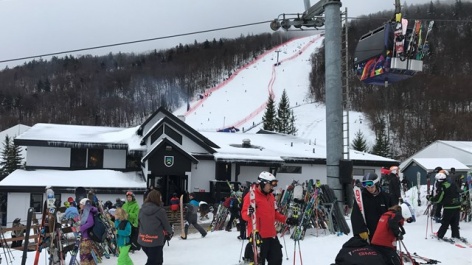


According to established US skiing historians such as Mark McLaughlin, skiing and eventually ski racing were apparently first introduced in the USA in the middle of the 19th Century - in the Sierra region, in the Western part of the country, when Norwegian miners attracted there by the ‘Gold Rush’ used “short wooden barrels stave mounted with crude leather bindings” to move around the Californian mountains during wintertime when the hills and the roads were covered by snow.
Some of them even steamed down some steep slopes at very high speed approaching 160 km/h (100 mph) on their very long skis up to 4,60 meters (or 15 feet) when taking part in some betting races! Fortunately, these long skis were soon replaced by shorter models allowing a few tourists to also enjoy smooth snow gliding in the region that is also proud to have hosted in 1910 the first steam-powered toboggan tow of a length of 290 m (or 950 feet). It was located in Truckee, California, not far from Squaw Valley where the women’s World Cup tour is returning next March.
Yet ski business really took off after WWI in the Eastern part of the country, mostly in New England, where many former European immigrants were happy to practice their preferred winter sport in the nearby mountains of Maine, New Hampshire or Vermont.
In 1934, the first skier-specific tow rope in the USA was installed at Woodstock, Vermont – it was a model inspired by a ski-lift build the previous year at Shawbridge, in the Laurentians outside Montreal, Quebec. Interestingly enough, that tow was driven by the rear wheel of a Ford Model A.
Within a few years, skiing quickly became a very popular winter sport activity north of New York City and west of Boston, and many touristic resorts popped out to welcome them over the weekends, the most famous ones being Stowe, in Vermont, Waterville Valley, in New Hampshire, Franconia, also New Hampshire or Sugarloaf, in Maine. Very soon the greatest ski population in North America was formed in that part of the northern continent, with estimated 20 million potential skiers/boarders.
Champions from the East
Some top US champions from the 1960s and 1970s grew up in the East, such as combined World Champion Billy Kidd, who is also an Olympic silver medal winner at Innsbruck 1964. The Cochran family was also established there – Barbara winning Olympic gold in Slalom in 1972 at Sapporo!
More recently, Mikaela Shiffrin also spent much time in the East, studying in Vermont’s Burke Mountain Academy, where she had been a day student for many years. “She craved the deep sense of community and the honesty and intimacy of friendships formed in Vermont”, according to ski expert Peter Oliver in his excellent story recently published in ‘Skivermont.com’.
So Mikaela stayed in Vermont as a boarding student when her parents left for Vail, before joining the US Ski Team. Two years ago, she even ended her studies there after having enjoyed her first international triumphs!
In fact, “Vermont is home to more ski academies than any other ski state, and they are all incubators for athletes, from Vermont and around the country, who aspire to the national team: Burke Mountain Academy, Green Mountain Valley School, Stratton Mountain School, Mount Mansfield Winter Academy, Killington Mountain School, Mount Snow Academy and Okemo Mountain School.” No surprise that the routs for skiing and racing are so strong there!
In March 1967, Franconia in New Hampshire, (also called Cannon Mt) hosted the first ever World Cup races in the US in front of a huge crowd – a total of six races for women and men took place there, three of them being won by France’s skiing legend Jean-Claude Killy! Twenty years later, a young kid homeschooled by his mother Jo spent entire days skiing (and crashing) there before returning in their home located in the middle of the woods – skiing’s whiz kid Bode Miller!
Even though Colorado, California, Idaho and sometimes Wyoming or Washington State welcomed the World Cup tour afterwards, the world’s best skiers often returned to New England, mostly at Waterville Valley where the Finals took place in 1969 and 1991, as well as Stratton Mountain in 1978 and Sugarloaf in 1971.
In the heydays of the Bob Beattie’s very spectacular Pro Tour from 1971 to 1981, his circuit often visited the often cold Eastern part of the country which surely reinforced the tradition of ski racing in that region. When the town of Aspen was awarded the Finals of the 2017 World Cup season some time ago, it didn’t take long to leaders of the US Ski Association to convince the management of the women’s tour to consider a candidature of an Eastern resort for that difficult Thanksgiving slot – in this case Killington, Vermont, one of the largest resorts in that region.
120 snow guns in action.
Managed by experts from Powdr Co, who used to run Park City and strongly support national teams from several nations in hosting excellent training camps in October and November in Colorado’s Copper Mountain, Killington attracts huge numbers of recreational skiers each winter in his vast domain of over 600 hectares (over 1,500 acres) covered by countless lifts. The top of the mountain - the Killington Peak - is situated at 1,293 meters (4,241 feet) and the basement at 325 meters (1,165 feet).
Considered the ‘Beast in the East’ for its facilities and its efficient snowmaking system, Killington worked hard to put together that first World Cup stage in the East since 1991 – using sometimes as much as 120 snow-guns over the steep ‘Superstar’ racing course early November. Despite sometimes warm temperatures which forced the cancellation of men’s ‘World Cup Classics’ as Lake Louise and Beaver Creek, the local crew encouraged and supervised by former US Head Coach and Powdr Corp’s SVP Herwig Demschar managed to put a layer of nearly two meters of man-made-snow on the challenging racing slopes! Everybody here hopes now that the weather will remain cold and stable for a few more days…
Because of Thanksgiving Day and the excitement created around that event, organizers expect over 15,000 visitors over the weekend. “The tickets for the grandstands were sold within a few hours,” explains Demschar. “Entrance for the general public is free so we believe it will be a great atmosphere here on race-days,” adds the Austria-born-manager whose kids are racing for … Australia!
Even though multiple World Champion Mikaela Shiffrin lives now with her family near Beaver Creek/Vail, she may well consider those upcoming competitions as’ home-races’! Obviously they mean a lot to her. “It will be something very special for me – I’ll encounter so many friends here, it’ll be amazing,” she said in recent weeks at Soelden and Levi.
Expect her to be skiing hard again for victory – as she did a year ago at Aspen !
©FIS - PkL - no reproduction/translation permitted
Source: fis-ski.com





